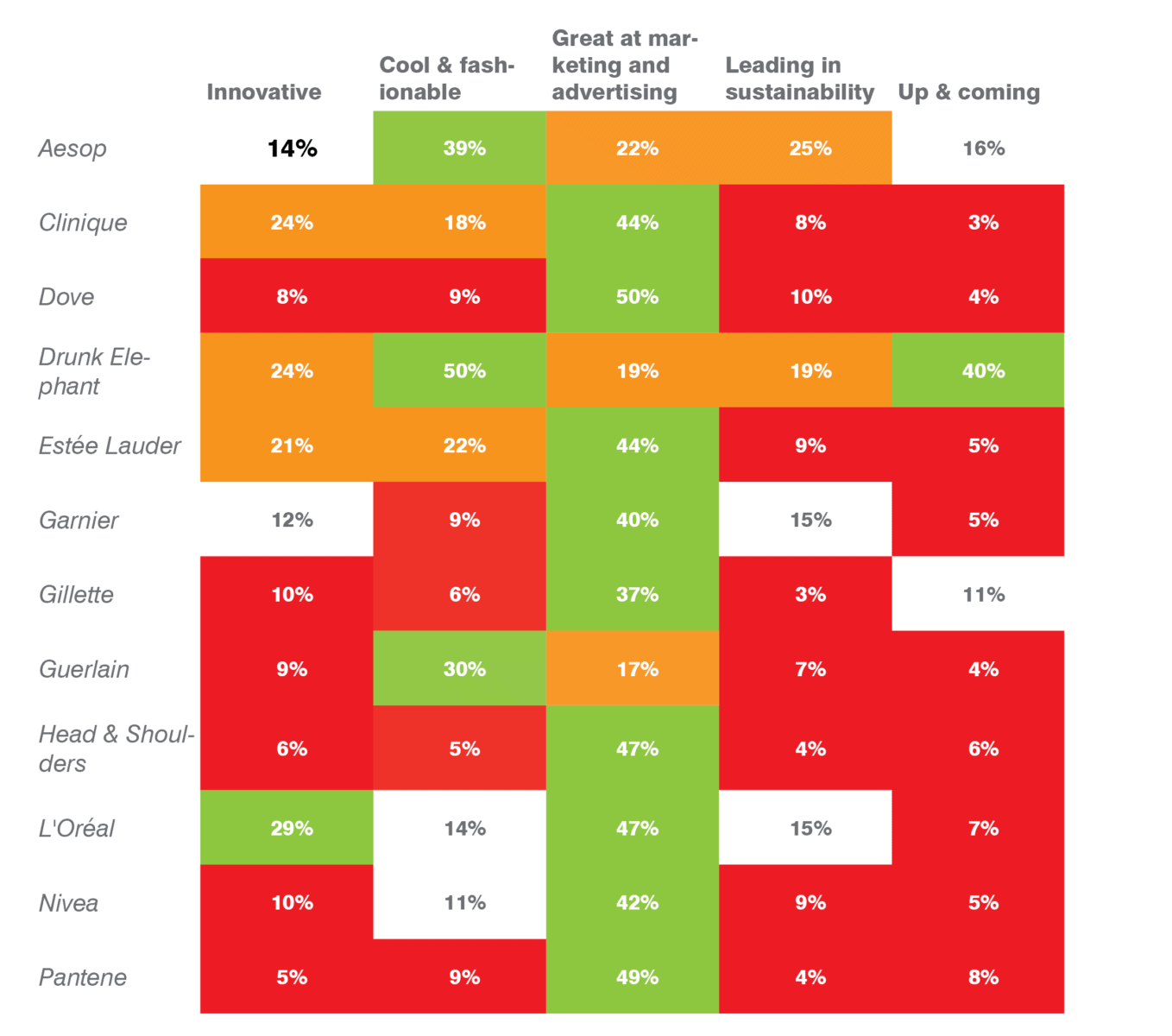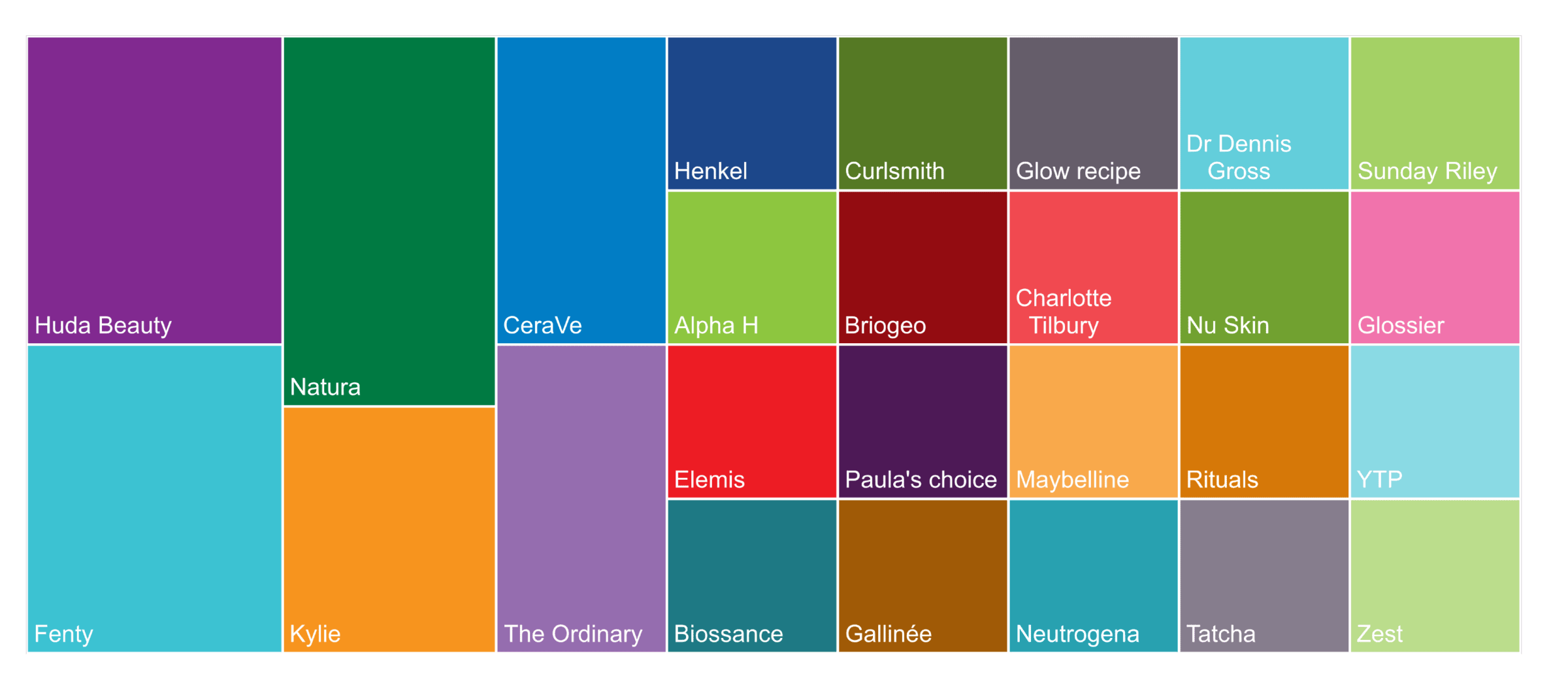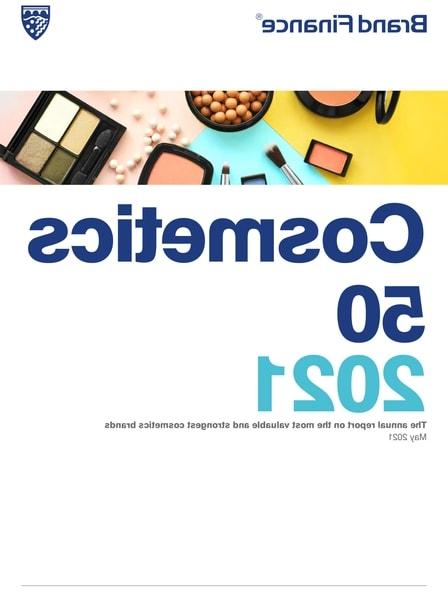Este ano, fizemos uma parceria com Cosmetics Business - A plataforma on -line líder para a indústria profissional de beleza, cuidados pessoais e produtos de higiene pessoal - para realizar uma indústria de pesquisa que a indústria de que os seus leitores é que o futuro da indústria de que o futuro. Perspectivas e principais players do mercado. Hoje? Com produtos em todos os setores, pois as pessoas foram forçadas a se tornar on-line para comprar como bloqueios induzidos por pandemia são impostos globalmente. Sentado em quarto, está a importância da recomendação de pares nas mídias sociais (4.02). Com os novos regulamentos rigorosos de publicidade em vigor nos canais de mídia social - os influenciadores agora devem declarar quando qualquer coisa é uma promoção, presente ou anúncio pago - a ambiguidade para os consumidores foi e, portanto, parece que a confiança aumentou. A brand’s transparency over product contents and claims scores only slightly behind online visibility, with a score of 4.10 out of 5. Over the previous few years, we have witnessed more and more challenger brands ride on the sustainability and ‘clean’ wave in order to differentiate themselves in the market and compete with the traditional powerhouses, in response to the ever-increasing pressures from Gen Z to ‘do better’ for the environment and future proofing the Planeta. Inovação e novos produtos (3,98); preço de preço (3,82); desejo de embalagem reduzida (3,61); e a ênfase de uma marca em seu cliente 'comunidade' (3,57). Com muitas dificuldades financeiras e o poder de compra de um impacto no último ano, pode -se esperar que isso tenha pontuado mais alto. Houve alguns movimentos consideráveis nas respostas. O desejo de marcas éticas e sustentáveis saltou 5 pontos, saindo no topo como o fator mais importante para os consumidores. O preço saltou 5 pontos para se tornar o terceiro fator mais importante. Da mesma forma, o impacto financeiro/social do Covid-19 saltou 3 lugares. Essas mudanças refletem o atraso no impacto da pandemia no consumidor, da qual foram amplamente protegidos até agora. Isso pode ser resultado de interação reduzida em geral, devido a permanecer em ordens domésticas - os consumidores simplesmente não têm a oportunidade de procurar conselhos e recomendações de cosméticos com a mesma facilidade e pessoalmente, como costumavam. No entanto, alguns entrevistados esperavam que as consequências econômicas e as interrupções da cadeia de suprimentos devido à pandemia tenham um grande impacto na demanda.
We conducted an online survey among 179 industry professionals, who were asked 22 questions on the cosmetics industry outlooks and key market players.
What drives consumer choice today?
Respondents were first asked what influences consumers when they purchase a product and were requested to score 12 factors out of 5, ranging from online visibility and transparency, to price and the social values of brands.
Coming out on top was brands’ online visibility and e-commerce availability, with a score of 4.24 out of 5. The role of digital has been propelled to the forefront of consumers’ interactions with products across all sectors, as people have been forced to turn online to purchase as pandemic-induced lockdowns are imposed globally. Sitting in fourth is the importance of peer recommendation on social media (4.02). With the new strict advertising regulations in place across social media channels – influencers now must state when anything is a paid promotion, gift, or advert – the ambiguity for consumers has gone, and thus it would seem trust has gone up.
But digital isn’t the only important factor – a brand’s stance on sustainability, its purpose, and its ethics are also key when driving consumer choice. A brand’s transparency over product contents and claims scores only slightly behind online visibility, with a score of 4.10 out of 5. Over the previous few years, we have witnessed more and more challenger brands ride on the sustainability and ‘clean’ wave in order to differentiate themselves in the market and compete with the traditional powerhouses, in response to the ever-increasing pressures from Gen Z to ‘do better’ for the environment and future proofing the planet.
Coming out as the least important factor according to Cosmetic Business’s readers is the financial/social impact of COVID-19, with a score of 3.55 out of 4.
Factors sitting in the middle are: recommendation from friends/ family (4.00); innovation & new products (3.98); price point (3.82); desire for reduced packaging (3.61); and a brand’s emphasis on its customer ‘community’ (3.57).
Perhaps the most surprising response was the price point, scoring quite low compared to other factors. With many experiencing financial difficulties and purchasing power taking a hit over the last year, one might have expected this to have scored higher.
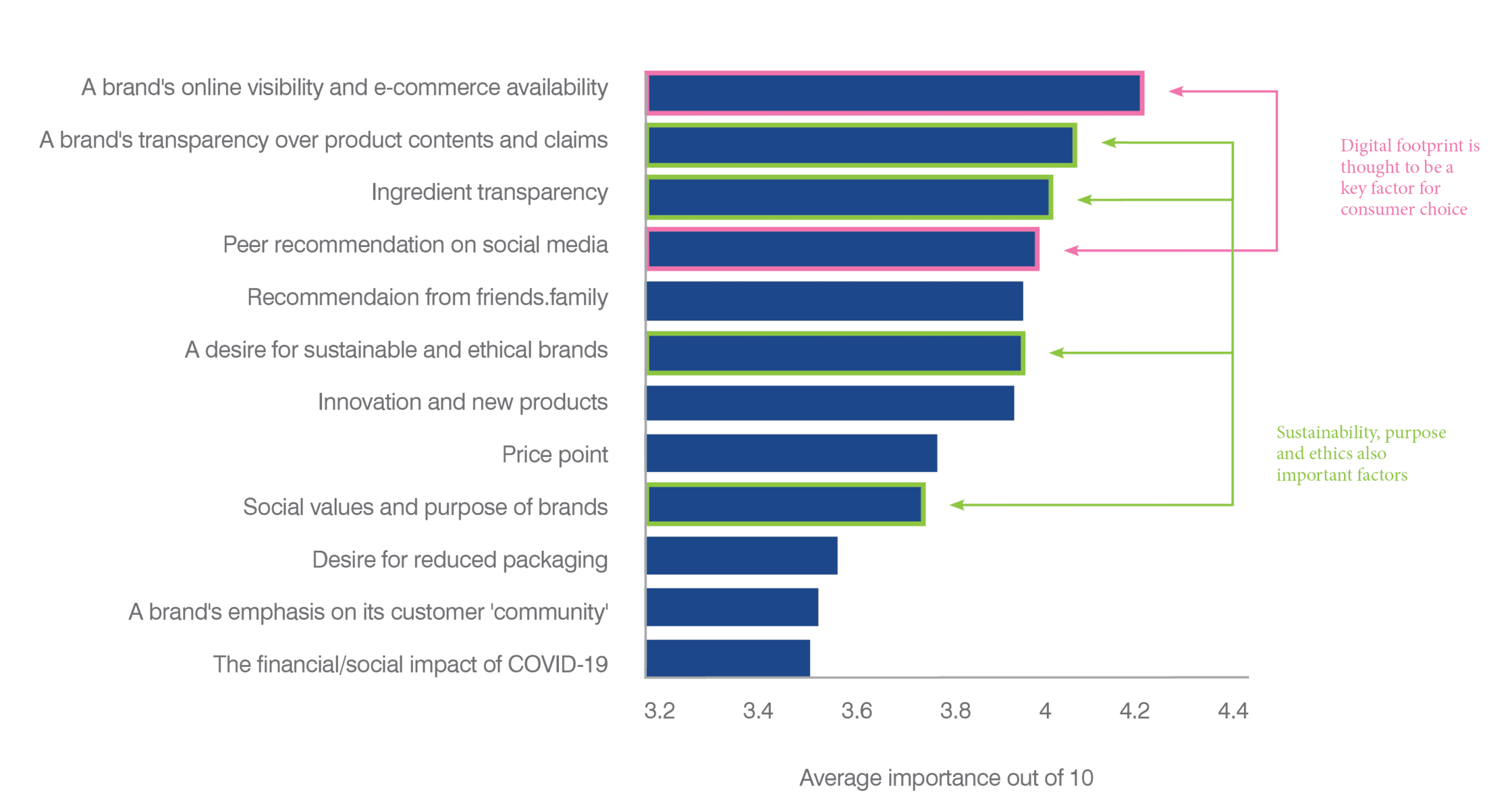
The year ahead
We then asked the same question, but this time asked what factor would have the largest impact on consumer choice in the coming year. There were some considerable movements in the answers. The desire for sustainable and ethical brands jumped 5 spots, coming out on top as the most important factor to consumers. The price point has jumped 5 spots to become the third most important factor. Similarly, the financial/social impact of COVID-19 has jumped 3 places. These shifts are reflective of the delay in the impact of the pandemic on the consumer, which they have been largely protected from thus far.
In contrast, recommendation from friends/ family, slipped the furthest down the ranking, down 5 spots to 10th. This may be a result of reduced interaction in general, due to stay at home orders – consumers simply don’t have the opportunity to seek cosmetics advice and recommendations as easily, and in person, as they used to.
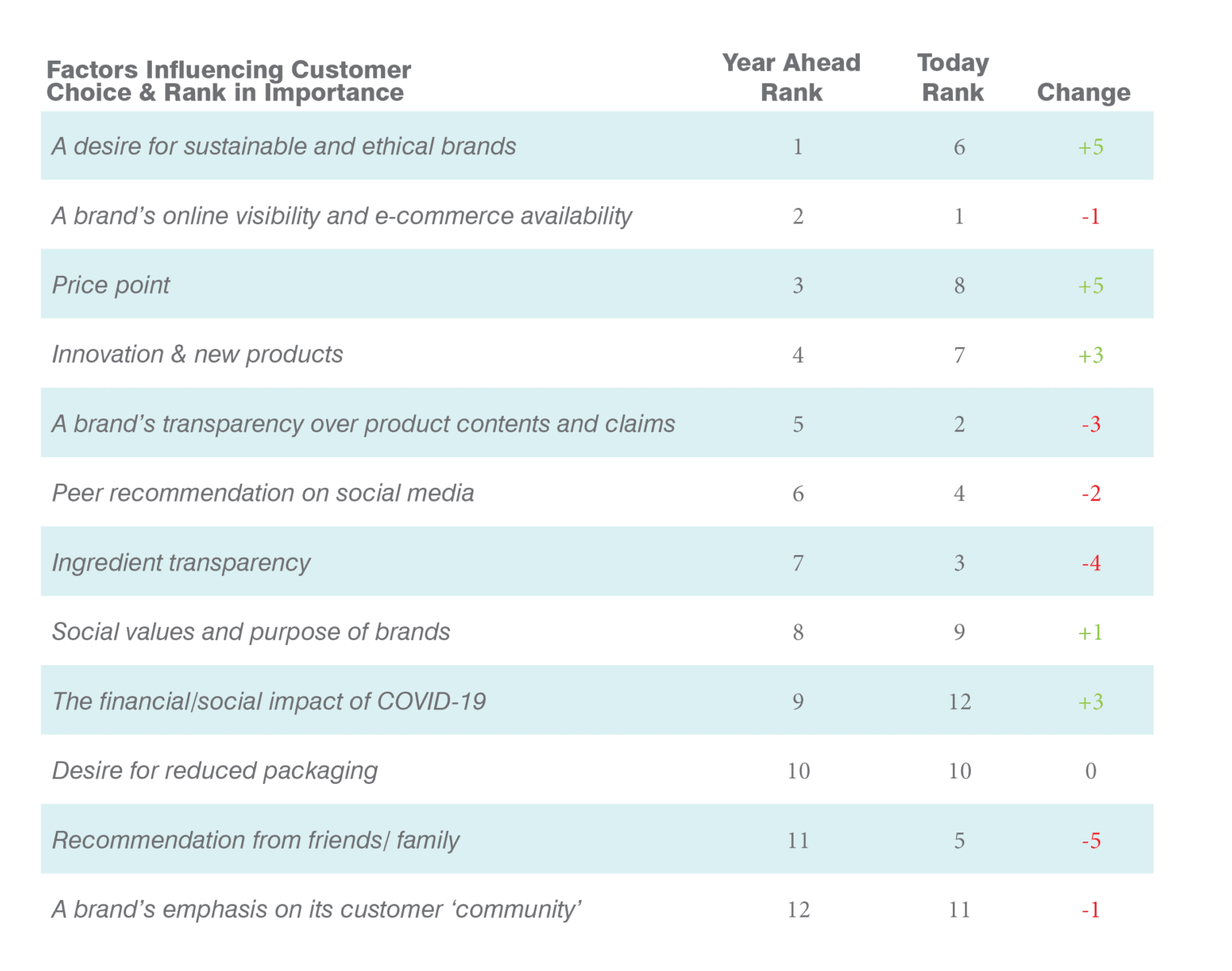
When asked about their outlook on the industry as a whole - as well as their organisation specifically - in general, survey respondents had a bullish, optimistic view. However, a few respondents expected the economic consequences and supply chain disruptions due to the pandemic to have a major impact on demand.
Historicamente, a indústria de cosméticos tem sido resiliente durante as crises financeiras, mas os bloqueios e as mudanças no estilo de vida causados pela pandemia significaram que algumas categorias, principalmente cosméticos coloridos, perderam. Embora algumas das vendas do setor tenham mudado on-line, o crescimento das vendas on-line não compensa o declínio nas vendas na loja testemunhadas no ano passado. Como sugere evidências do mercado chinês, apesar da loja reabrir e dos "gastos com vingança", as vendas não se recuperaram totalmente. Esperamos, portanto, o retorno aos níveis de vendas pré-pandêmicos levará tempo e veremos mudanças fundamentais na composição da indústria entre agora e depois. Os cuidados com a pele e os cabelos eram líderes evidentes, com os entrevistados acreditando que crescerão 93% e 86%, respectivamente. No outro extremo do espectro, as fragrâncias e os cosméticos de cores são considerados os produtos de crescimento mais lento em todo o setor no próximo ano. Com o aumento forçado dos tratamentos de spa em casa, esses resultados talvez não sejam surpreendentes. O aumento exponencial da ligação de vídeo este ano, forçando homens em empregos de colarinho branco a se olhar com muito mais frequência, poderia ter causado esse resultado. Pacote

Product outlook
As well as looking at the sector as a whole, respondents were asked about specific products and how they would fare in the coming year following global lockdowns. Skin care and hair care were evident leaders, with respondents believing that they will grow 93% and 86%, respectively. At the other end of the spectrum, fragrances and colour cosmetics are perceived to be the slowest growing products across the sector in the coming year. With the forced rise in home spa treatments, these results are perhaps unsurprising.
61% of respondents believe that male grooming would grow the fastest among the subcategories. The exponential rise in video calling this year, forcing men in white collar jobs to look at themselves a lot more frequently, could have caused this result.
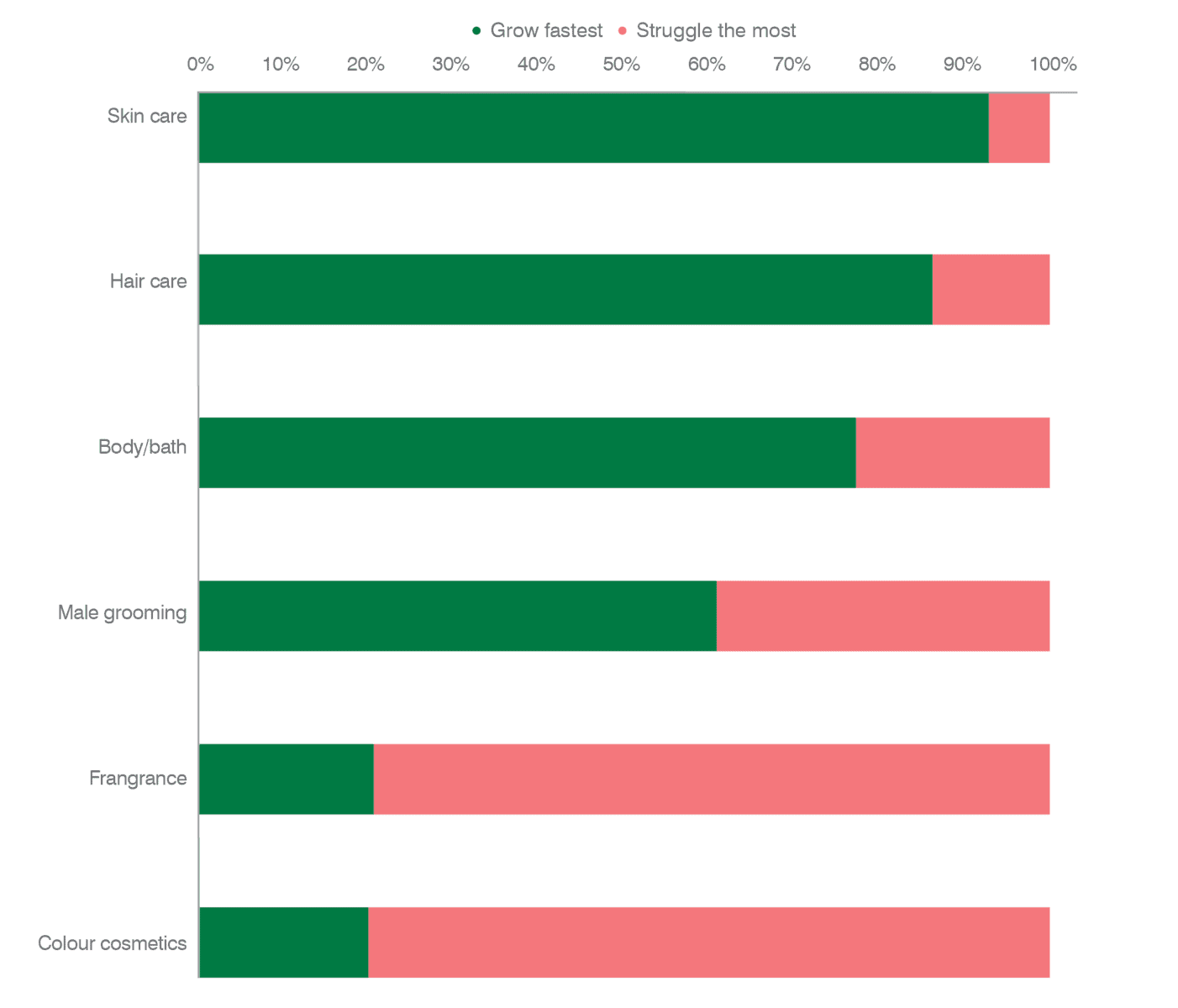
Pacote de leads da Unilever
Os leitores de negócios de cosméticos foram perguntados sobre quais dos gigantes FMCG eles mais admiravam de Estée Lauder, Procter & Gamble, L’Oréal, LVMH Moët, and Unilever com base em seis critérios: reputação no setor; Portfólio de marcas; força financeira; inovação; sustentabilidade ambiental; e Recurso do Emprego. A marca também sai por cima de uma margem considerável - com 53% dos entrevistados concordando - por serem os mais admirados por sua sustentabilidade ambiental. Essa é uma vitória importante, dado que foi identificado como um dos fatores mais importantes que influenciam a escolha do consumidor hoje e cada vez mais no próximo ano. Portanto, se a Unilever puder transmitir efetivamente esta mensagem para encerrar os consumidores, suas marcas provavelmente se beneficiarão. Outras métricas que a Unilever realizou no topo foram apelo de emprego (33%) e força financeira (27%). No outro lado, a marca teve um desempenho pior por sua reputação no setor, com apenas 10%dos entrevistados concordando que ela era admirada por isso.
Unilever performs strongest across the board, scoring highest across three of the criteria. The brand also comes out on top by a considerable margin – with 53% of respondents agreeing – for being the most admired for its environmental sustainability. This is an important win, given this was identified as one of the most important factors influencing consumer choice today and increasingly in the year ahead. Therefore, if Unilever can effectively convey this message to end consumers, its brands are likely to benefit. Other metrics that Unilever performed top on were employment appeal (33%) and financial strength (27%). At the other end, the brand performed worst for its reputation in the industry with only 10% of respondents agreeing that it was admired for this.
Estée Lauder sits just behind Unilever topping the two metrics on reputation in the industry (46%) and brand portfolio (29%).
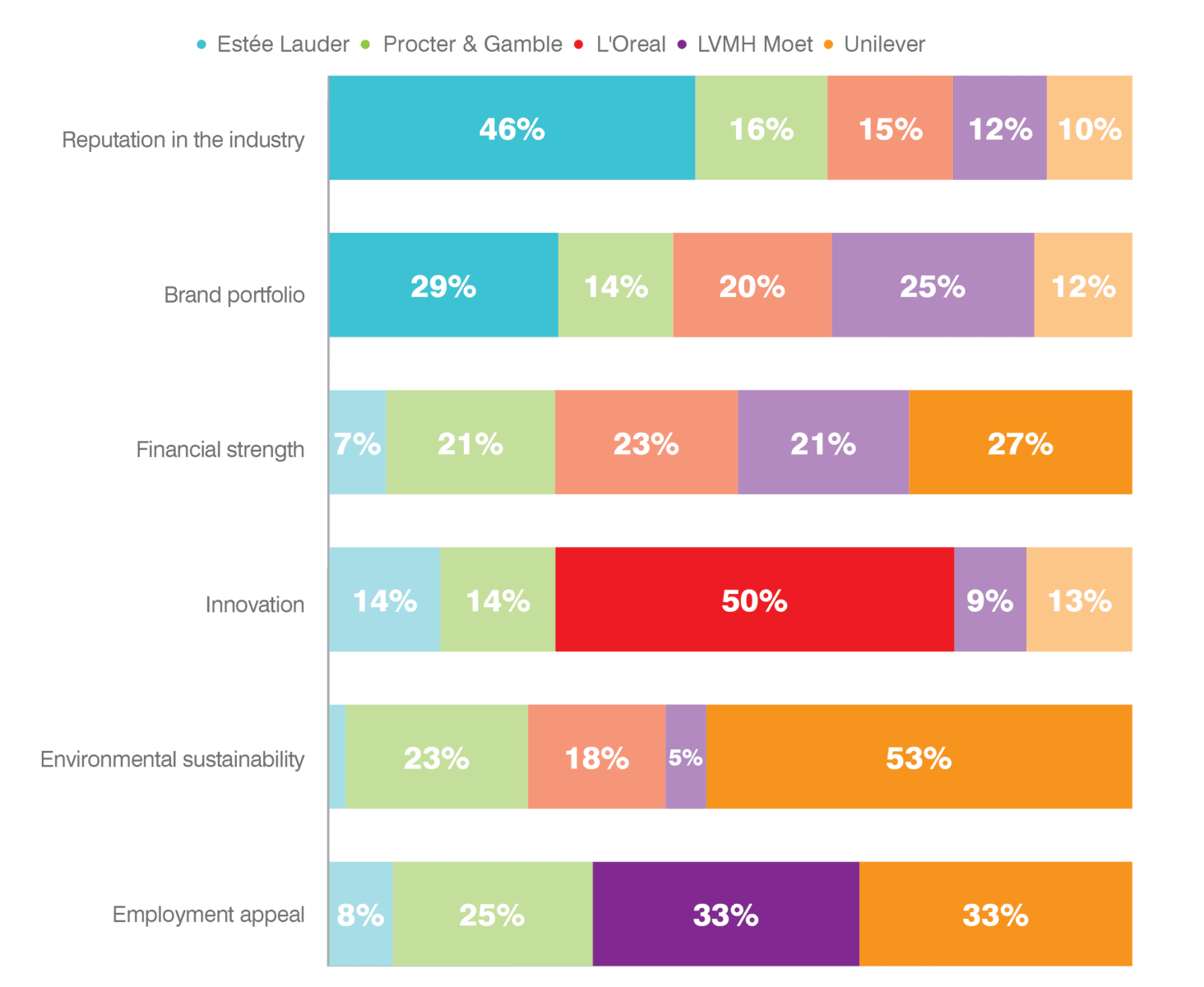
Marcas de topo de mente
A próxima pergunta foi um mergulho mais profundo em produtos específicos da indústria, observando o quão bem eles eram conhecidos e quão bem eles foram admirados. marca. Toda a gama Nivea está centrada no Nivea Blue, dando à marca um valor de reconhecimento extremamente alto, conforme demonstrado nos resultados. Da mesma forma, a L'Oréal obtém 98% para familiaridade. O tamanho e a diversidade do portfólio significam que o nome e os produtos são difíceis de evitar e, portanto, conhecidos em todo o mundo.
With the iconic blue packaging - which the brand says represents trust, closeness, and care - Nivea has come out on top, with 98% of respondents saying they are familiar with the brand. The entire Nivea range is centred on Nivea Blue, giving the brand extremely high recognition value as demonstrated in the results. Similarly, L’Oréal scores 98% for familiarity. The sheer size and diversity of the portfolio means that the name and products are hard to avoid and therefore known the world over.
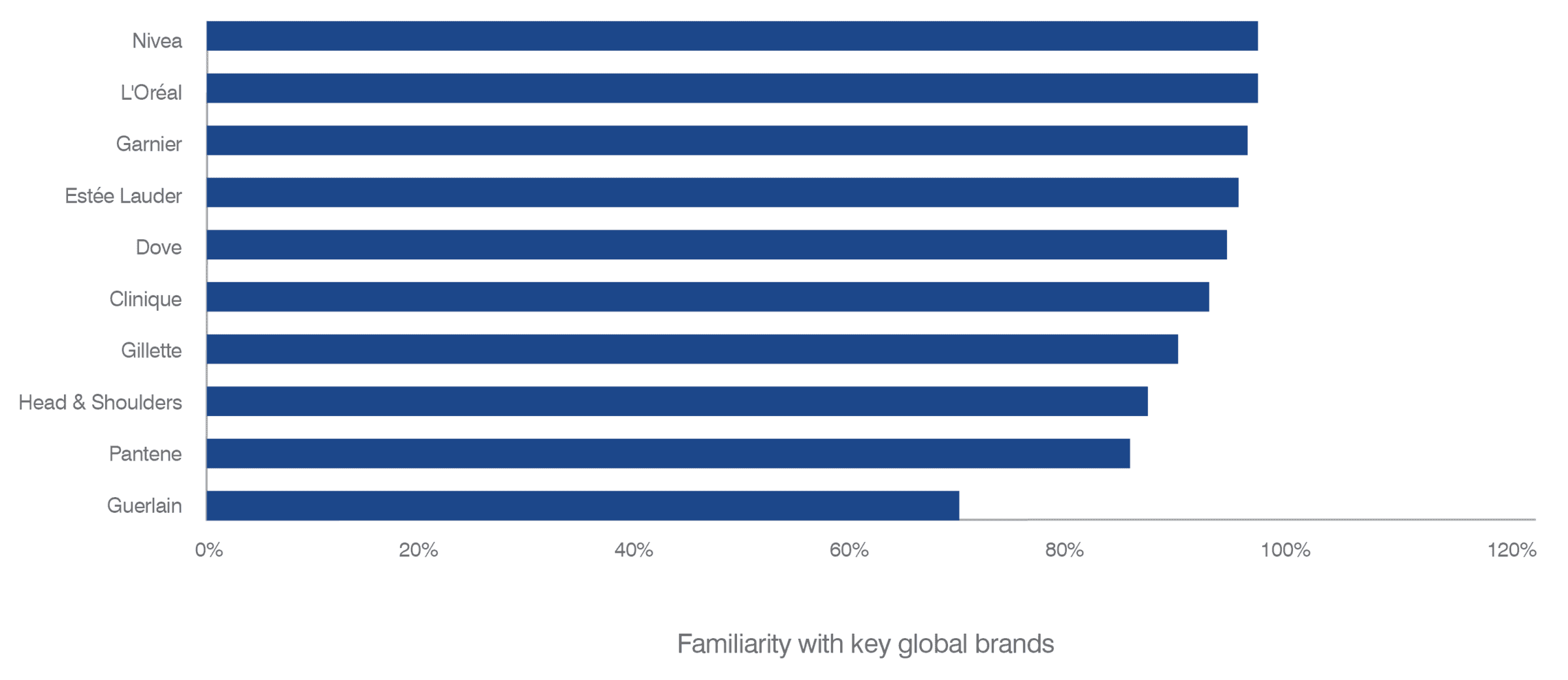
das marcas perguntadas sobre, Aesop e o elefante bêbado pontuou mais baixo para familiaridade em 47% e 54%, respectivamente. No entanto, ao correlacionar a familiaridade com a admiração, foram essas marcas mais recentes "mais frias" que superaram seus colegas - com níveis mais altos de admiração. Marcas mais estabelecidas -Pantene, Gillette, Head & Shoulders, and Garnier – under deliver in the survey, scoring high on familiarity, but low on admiration. Leaders L’Oréal and Estée Lauder have high shares of admiration, partially driven by their high familiarity scores.
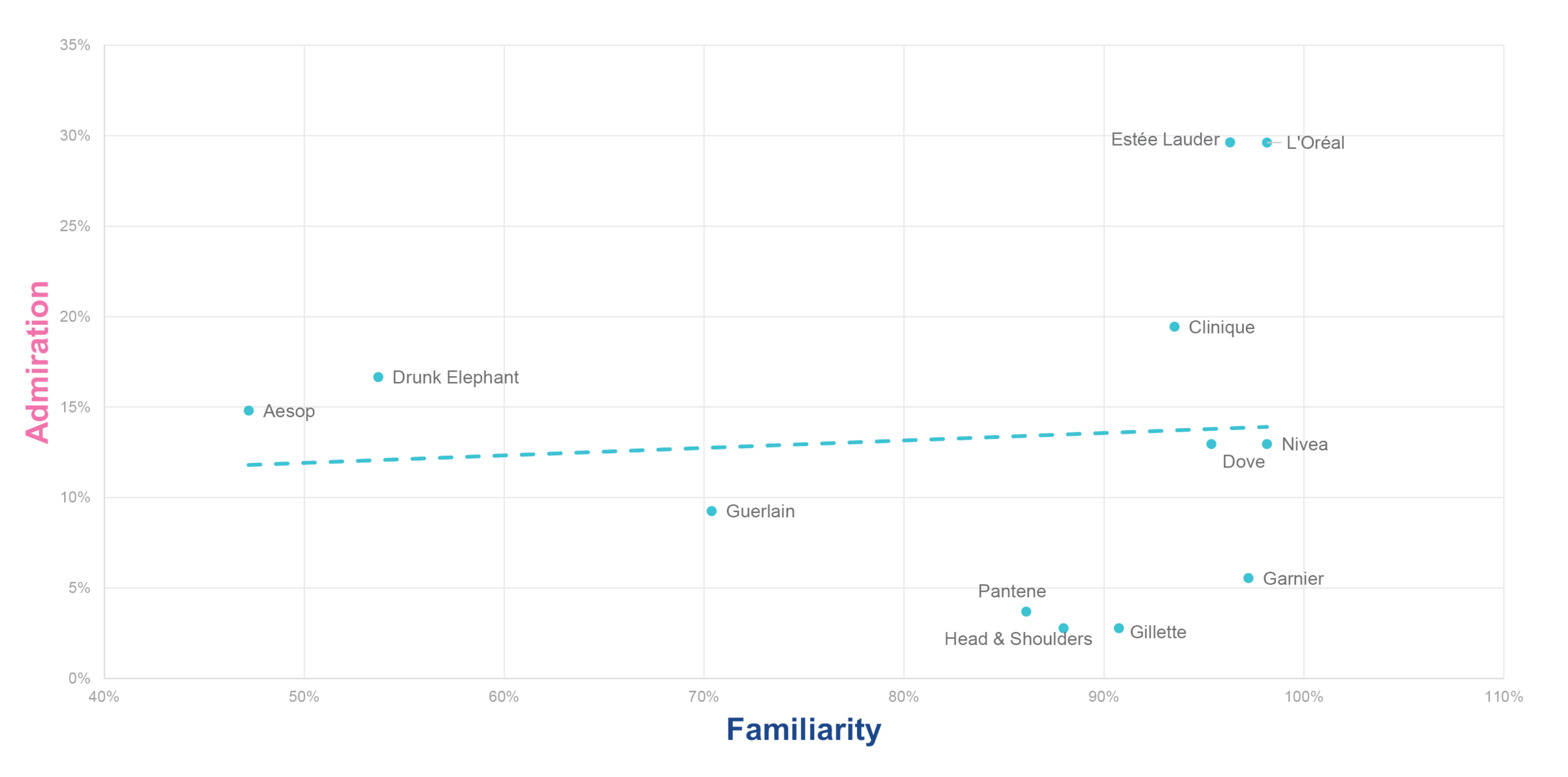
Quando perguntado sobre quais marcas eles acreditavam que seriam "gostosos" no próximo ano, as marcas Challenger chegaram ao topo dos líderes tradicionais da indústria, com os favoritos da geração Z sinalizados, incluindo Huda Beauty, Fenty, Natura, e o comum.
